3 Foolproof Tips for Great Ball Striking
One Key Concept, Three Easy Tips—Why Didn’t Anyone Ever Tell You Great Ball Striking Could Be So Easy?
What comes to mind when you imagine great ball striking?
Probably the sound, right? The clean, solid thwack!
Then there’s the feeling—oh man, you know that feeling. It’s that powerful reverberation that runs from the center of the clubface up through the shaft and into your hands and arms. For a lot of golfers, that sensation is the best part of the game.
So it’s no surprise that the vast majority of students who show up on my lesson tee are there to improve their iron contact. They want to make great ball striking—that feeling of solid, centered control—a consistent part of their game.
And it gives me a lot of satisfaction to show them that improving contact with their irons isn’t hard at all.
In fact, there are three things I always look for in a student’s swing when they’re struggling with contact. If a golfer can nail down these three concepts, they will improve their ball striking.
The best part? These concepts are so easy to master.
I’m going to walk you through each one. Then I’ll offer you a bonus tip you can bring to the golf course tomorrow and see immediate results, even if you forget to apply these other strategies.
First, we gotta talk about what we really mean when we talk about great ball striking.
The Secret to Great Ball Striking
Excellent contact is ultimately about one thing:
Controlling the low point of your swing.
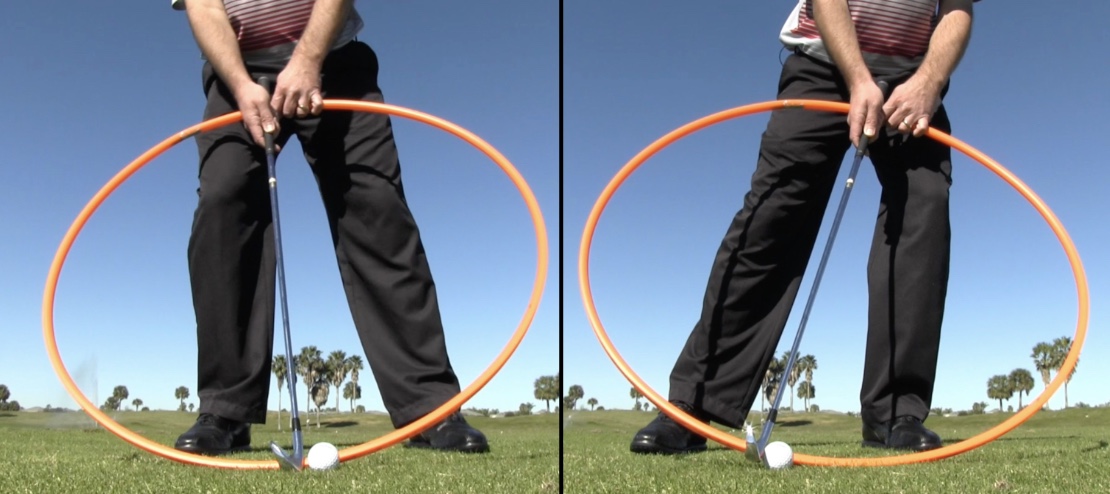
When you’re hitting an iron, you want to hit down on the golf ball, meaning that impact occurs when the clubhead is still moving at a downward angle. (You have the opposite goal when you’re hitting your driver. You can learn more about that here.)
In order to hit the ball at a downward angle, you need to make sure your swing reaches its low point just after impact. To put it another way, you want to hit the ball before the turf.
If you hit the low point before you make contact with the ball, you’re going to catch the ball on an upward trajectory.
That’s how you end up chili dipping and topping it.
Each of the three tips I’m about to teach you focus on that one simple goal: making sure your low point happens at the right place.
I know that sounds like a precision skill, but you’re about to learn the cheat code. These tips set you up to perfect that low point naturally, without even thinking about it.
Keep reading if you’re ready to build a reputation for great ball striking.
Tip #1: Ball Position
This tip is the epitome of effortless, but so few golfers even give it second thought.
The position of your golf ball within your stance determines where the ball will be in relation to the low point. If you get it too far forward in your stance, you’ll make contact after the low point, which means you’ll hit up on it. Not what we want for iron shots.
For irons, think about getting the ball somewhere between the buttons and logo of your golf shirt. To find the perfect spot, I recommend using an alignment rod. (If you don’t have one, VLS Golf has a set of collapsible allignment rods that offer great versatility for practicing all kinds of skills.)
Follow these steps to get your ball in the optimal spot:
- Set the alignment rod in the center of your stance, pointing directly at the golf ball.
- Position your feet side-by-side with the alignment rod between them.
- Step your lead foot towards the target.
- Step your trail foot a slightly greater distance away from the target.
Just as an illustration, let’s say you step your lead foot out four inches. In that case, you might step your trail foot out about five inches. There should be a difference, but not a massive difference.
The actual size of your steps will depend on the width of your typical golf stance. When in doubt, check to make sure the ball aligns with the space between the buttons and logo on your shirt.
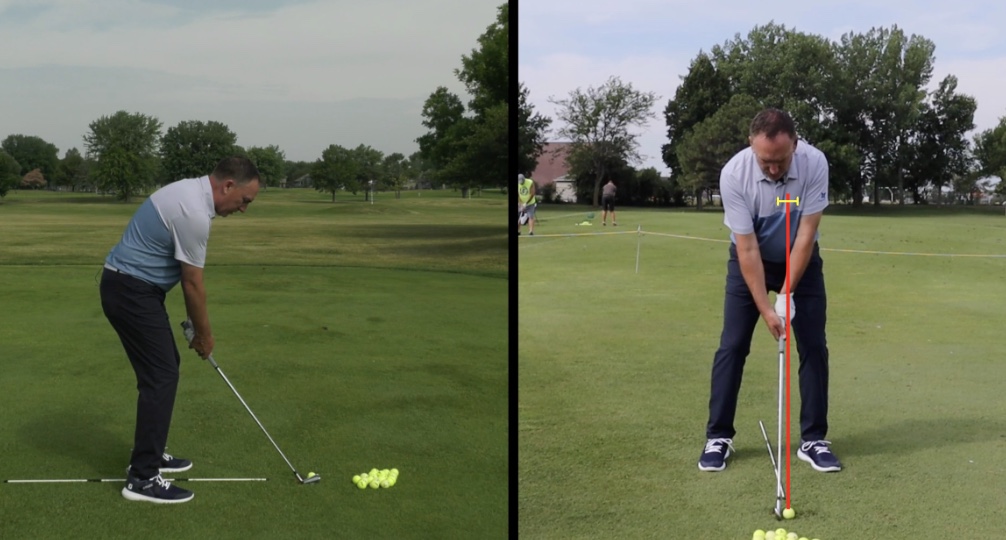
Once you’ve got the ball in the right place, all that’s left to do is make sure you don’t accidentally shift the low point as you move through your swing. These next two tips will help you avoid that common mistake.
Tip #2: Pressure Shift
The first thing you want to pay attention to is the pressure shift in your feet throughout your swing. (You can also think of this as a weight shift.)
When you take your setup, you should have about 60% of your weight pressing down into your lead foot and about 40% in your trail foot. If you follow the Vertical Line Swing System, you already know that this 60/40 balance doesn’t just help with great ball striking; it gets you killer distance, too.
(If you’re not familiar with the Vertical Line Swing System, it’s a technique I developed specifically for casual and senior golfers. You can learn more about it here.)
On the backswing, shift the majority of the pressure into your trail foot. Then as you swing down and through, the pressure should shift back into your lead foot.
This is extremely important for contact because your low point moves with the pressure shift.
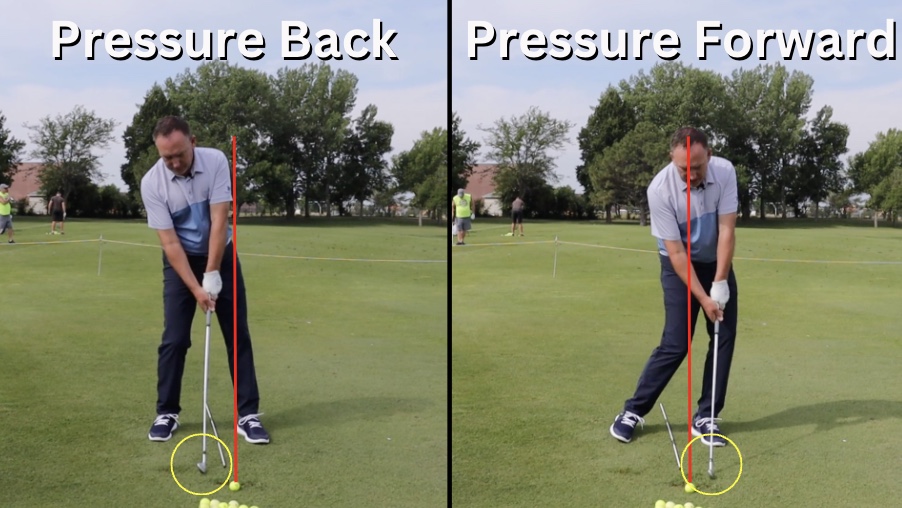
See, a lot of amateur golfers tend to shift more pressure into their trail foot on the downswing. It’s an instinctive strategy for getting the ball up in the air, but it doesn’t work. Why not?
Because when you keep your weight back, you move the low point back, too. Now the low point is behind the ball, and you’re heading for a chili dip.
Always shift your weight into the lead foot as you swing down.
Tip #3: Swing Direction
This is the other swing error you want to keep an eye on.
A lot of golfers swing their lead arm in and around on the backswing. In fact, there’s a good chance you were taught to do this. The theory goes that a flat backswing helps you generate more power.
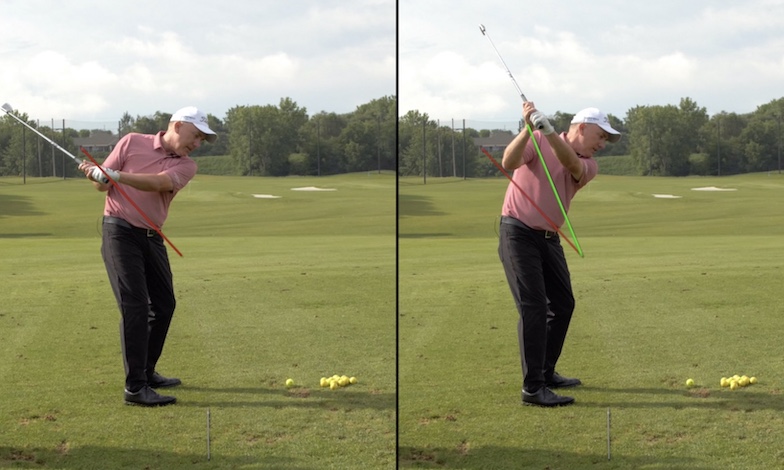
The only problem is that a flat backswing also demands deeper rotation and precision: two things that just aren’t accessible for senior golfers. This advice—like most traditional instruction—is based on the abilities of professional golfers.
So guess what happens when most of us mere mortals try to work this kind of backswing?
That’s right: we inadvertently move the low point backwards.
This is why I advocate so strongly for the Vertical Line Swing. In this technique, you swing the arm up and back on a more vertical plane. Not only does this help you get a longer swing without the twisting, it also helps you keep the low point where it belongs.
(Quick tip: If you want to learn more about the Vertical Line Swing, I wrote a whole book about it. It’s called The Bad Lie and you can find it here.)
Bonus Tip: One Simple Trick You Can Use Immediately
I think it’s clear by now that I wasn’t kidding when I said these tips would be easy. But if you’re looking for the quickest route to great ball striking, this is it:
Get your knees touching and the club handle high on your finish.
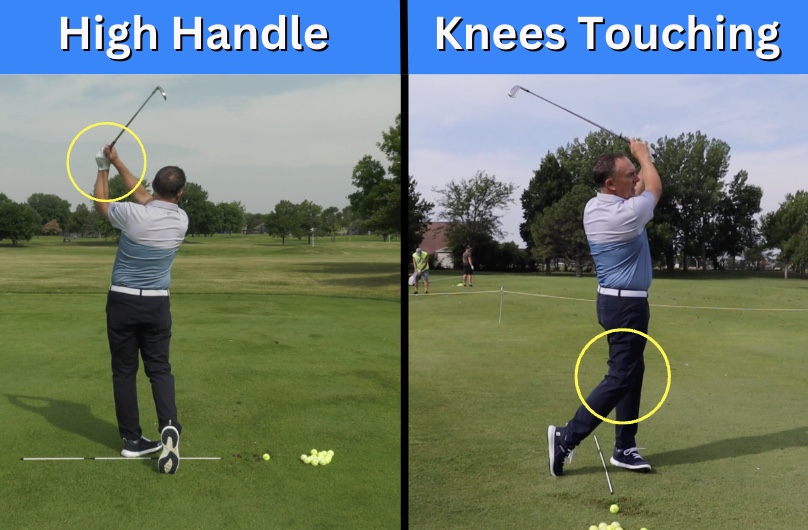
This is what we call “the Arnold Palmer finish,” and you’ll be shocked by the way it affects your entire swing motion. Simply chasing that goal of ending with your knees touching and your hands high forces you to shift your weight naturally and follow along a more vertical swing path.
And, of course, make centered, solid contact.
Great Ball Striking: A Recap
The next time you’re headed to the golf course, here are the tips to keep in mind:
- For iron shots, position the golf ball between the buttons and logo of your shirt.
- Remember to shift your weight back into the lead foot on the downswing.
- Swing your lead arm up and back on the backswing, not in and around.
- Finish with your knees touching and the handle high.
Give these tips a shot, then let me know:
Did This Advice Improve Your Ball Striking?
Is anything here unclear? Do you have your own tips to share?
Join us in the comments and share your thoughts! We always love hearing from you.
And if you’re looking for more advice and great products geared towards casual and “experienced” golfers, visit VLSGolf.com! We’re constantly putting out more instruction, equipment, and training aids tailored to the needs of the everyday golfer.


Great video, Todd! Thanks! 71 yo from Mobile, AL. I’ve always struggled with a too much inside and flat swing, even though I’m 6’9″. I try to get the club as vertical as I can, as quickly as I can, by pushing my left palm down on the butt of the club and pulling up with my right index finger. I still sometimes hit shanks with my wedges, though! Is this because I’m getting too flat??? Do I need to stay connected with both arms to my chest througout the swing??? Thanks!
Greg,
Thanks for the comment. Yes, it could be that the club is working too around on the backswing. Take a look at this video https://youtu.be/GcOUunxpz-g
Great info for position of ball between logo and buttons on shirt. My question is how about how far back or how close to stand from the ball and how to determine when you are in the right spot? Thanks Ben
Ben,
Good question. Here is a great video we did on the topic that will help https://youtu.be/DpYXilOgpWk
Great video Todd
Can’t wait to get out there and practice
Keith Cornwall
Thanks! Have you been follow us on YouTube as well?See here https://www.youtube.com/channel/UCgz5-3igA0IfsyWGKTr6YKA
Thanks Todd but the video did not answer my question above. I understand the flared toes, more pressure on lead foot etc but when the ball is in front of me how far back do I stand behind the ball? Is there a special distance behind the ball or is the angle of the shaft a certain degree or how can I judge how far back behind the ball I should be standing?
Ben,
This video covers it all in detail, enjoy https://youtu.be/t0Dyp7qMa7s?si=HBmBxWaCAjtBlyvM
Todd, I have a question regarding the left heel (lead foot as I am right-handed). Should the left foot stay planted on the ground when using an iron. I have a problem raising my left heel with iron shots and this seems to cause me to over-rotate and my shot ends up going weakly to the left. I have studied your videos and your left foot appears to stay planted on the ground with an iron and on your drives it slightly comes off the ground. I would appreciate what your thoughts are here and, if the left heel should stay planted , then do you have any drills to help with this? Thanks for all you do. Bought the Maxvert Driver and have your book. I am 64 and from Chicago area.
Joe
Joe,
Thanks for the kind words. In regards to your question, as we age I like to see the lead heal come off the ground slightly. It is not mandatory, but advised. Here is a great video we did some time back that will help https://youtu.be/COKstLARbeA?si=UtW0QVHvLTd6jcYW